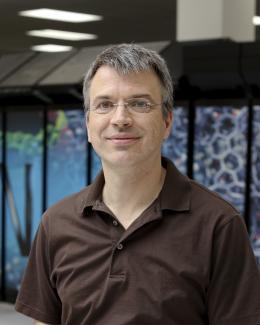OAK RIDGE, Tenn., Nov. 2, 2015—An international team led by Gaute Hagen of the Department of Energy’s Oak Ridge National Laboratory used America’s most powerful supercomputer, Titan, to compute the neutron distribution and related observables of calcium-48, an isotope with an atomic nucleus consisting of 20 protons and 28 neutrons. Computing the nucleus from first principles revealed that the difference between the radii of neutron and proton distributions (called the “neutron skin”) is considerably smaller than previously thought. The collaboration also made predictions for physical quantities that are current targets of precision measurements. These calculations also impact the size of a neutron star, thereby connecting objects that differ in size by 18 orders of magnitude. The work is published in the journal Nature Physics.
“We built a nucleus from scratch from its basic constituents—protons and neutrons,” said Hagen, a theoretical physicist who initiated and led the project with an award from DOE’s Office of Science Early Career Research Program. “To solve this strongly correlated system of 48 nucleons is far from trivial, because it is a complicated quantum mechanical many-body problem. Many things had to come together—accurate nuclear forces, sophisticated computational algorithms and a powerful tool such as Titan at ORNL—to achieve these results.”
While the distribution of electric charge inside the atomic nucleus is well known from experiments involving electron scattering, the distribution of the neutrons, which have no electric charge, is difficult to measure. In the nucleus of calcium-48, which has eight more neutrons than protons, the neutron distribution extends beyond the charge distribution and thereby sets the actual size of this nucleus. “This is the first really reliable calculation of such a massive nucleus from first principles,” said Hagen. “We reproduced basic observables for the first time by building this nucleus from scratch. We’ve answered a basic question—what is the size of the atomic nucleus?”
The ORNL-led team calculated radii, binding energies and dipole polarizabilities for helium-4, oxygen-16 and calcium-40 and accurately reproduced measurements of these isotopes. “That was a quality check of our calculation,” Hagen said. “It gives us confidence about our predictions for calcium-48.”
The team, which included partners from the University of Tennessee, Michigan State University, Chalmers University of Technology (Sweden), TRIUMF (Canada), Hebrew University (Israel), Technical University Darmstadt (Germany), University of Oslo (Norway) and University of Trento (Italy), turned to Titan, a Cray XK7 system at Oak Ridge Leadership Computing Facility, a DOE Office of Science User facility at ORNL. The project ran the nuclear structure code NUCCOR (Nuclear Coupled Cluster at Oak Ridge), for about 15 million CPU hours, allocated through the Innovative and Novel Impact on Theory and Experiment program.
Researchers at Jefferson Lab are preparing to measure the neutron radius of calcium-48. A team of physicists, the Darmstadt-Osaka Collaboration, has already measured its dipole polarizability and is analyzing the results. The findings could validate the work of Hagen’s team and constrain future theoretical models.
The title of the Nature Physics paper is "Neutron and weak-charge distributions of the 48Ca nucleus."
This research was also supported by the DOE Office of Science, in part through an Office of Science Early Career Research Program Award to Hagen. In addition, the work used resources of the Jülich Supercomputing Center in Germany. Other support came from the U.S. National Science Foundation, the European Research Council, the United States–Israel Binational Science Foundation, and the governments of Canada, Italy, Norway and Sweden.
UT-Battelle manages ORNL for DOE’s Office of Science. The single largest supporter of basic research in the physical sciences in the United States, the Office of Science is working to address some of the most pressing challenges of our time. For more information, please visit http://energy.gov/science/.—by Dawn Levy





